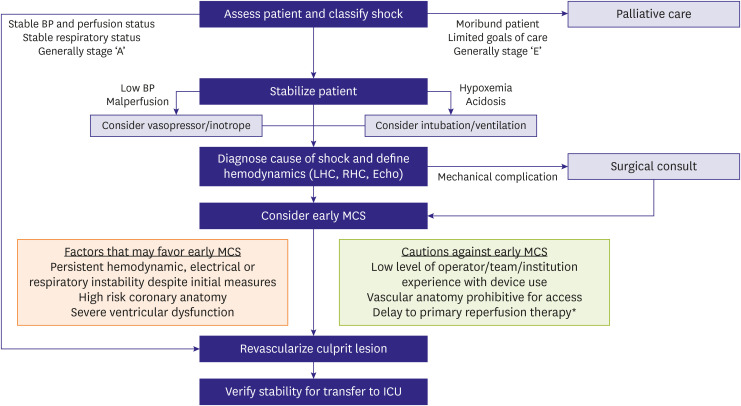Korean Circ J.
2021 Jun;51(6):487-494. 10.4070/kcj.2021.0102.
Real-World Data on the Intravascular Microaxial Left Ventricular Flow Pump (Impella) in High-Risk Patients
- Affiliations
-
- 1The Duke Clinical Research Institute, Durham, NC, USA
- KMID: 2516209
- DOI: http://doi.org/10.4070/kcj.2021.0102
Abstract
- Mechanical circulatory support (MCS) devices maintain or improve hemodynamic profiles in patients at risk for hemodynamic deterioration during percutaneous coronary intervention (PCI) or those in cardiogenic shock. Clinical trials of MCS have been difficult to complete due to challenges with equipoise; however, there are several “real-world” comparative effectiveness analyses of outcomes of patients undergoing high-risk PCI or cardiogenic shock with different MCS. This review summarizes the real-world data on Impella and intra-aortic balloon pump, 2 of the most commonly used MCS, and provides insight into the limitations of such data and challenges to completing clinical trials.
Figure
Reference
-
1. O'Neill WW, Kleiman NS, Moses J, et al. A prospective, randomized clinical trial of hemodynamic support with Impella 2.5 versus intra-aortic balloon pump in patients undergoing high-risk percutaneous coronary intervention: the PROTECT II study. Circulation. 2012; 126:1717–1727. PMID: 22935569.2. Nanna MG, Peterson ED, Chiswell K, et al. The incremental value of angiographic features for predicting recurrent cardiovascular events: insights from the Duke Databank for Cardiovascular Disease. Atherosclerosis. 2021; 321:1–7. PMID: 33582446.
Article3. Garcia S, Alraies MC, Karatasakis A, et al. Coronary artery spatial distribution of chronic total occlusions: insights from a large US registry. Catheter Cardiovasc Interv. 2017; 90:23–30. PMID: 27860111.
Article4. Brennan JM, Curtis JP, Dai D, et al. Enhanced mortality risk prediction with a focus on high-risk percutaneous coronary intervention: results from 1,208,137 procedures in the NCDR (National Cardiovascular Data Registry). JACC Cardiovasc Interv. 2013; 6:790–799. PMID: 23968699.5. Ait Ichou J, Larivée N, Eisenberg MJ, Suissa K, Filion KB. The effectiveness and safety of the Impella ventricular assist device for high-risk percutaneous coronary interventions: a systematic review. Catheter Cardiovasc Interv. 2018; 91:1250–1260. PMID: 28941078.
Article6. Maini B, Naidu SS, Mulukutla S, et al. Real-world use of the Impella 2.5 circulatory support system in complex high-risk percutaneous coronary intervention: the USpella registry. Catheter Cardiovasc Interv. 2012; 80:717–725. PMID: 22105829.
Article7. Cohen MG, Matthews R, Maini B, et al. Percutaneous left ventricular assist device for high-risk percutaneous coronary interventions: real-world versus clinical trial experience. Am Heart J. 2015; 170:872–879. PMID: 26542494.
Article8. Khera R, Cram P, Lu X, et al. Trends in the use of percutaneous ventricular assist devices: analysis of national inpatient sample data, 2007 through 2012. JAMA Intern Med. 2015; 175:941–950. PMID: 25822170.9. Philipson DJ, Cohen DJ, Fonarow GC, Ziaeian B. Analysis of adverse events related to Impella usage (from the Manufacturer and User Facility Device Experience and National Inpatient Sample Databases). Am J Cardiol. 2021; 140:91–94. PMID: 33147430.
Article10. Amin AP, Spertus JA, Curtis JP, et al. The evolving landscape of Impella use in the United States among patients undergoing percutaneous coronary intervention with mechanical circulatory support. Circulation. 2020; 141:273–284. PMID: 31735078.
Article11. Dhruva SS, Ross JS, Mortazavi BJ, et al. Association of use of an intravascular microaxial left ventricular assist device vs intra-aortic balloon pump with in-hospital mortality and major bleeding among patients with acute myocardial infarction complicated by cardiogenic shock. JAMA. 2020; 323:734–745. PMID: 32040163.12. Basir MB, Pinto DS, Ziaeian B, et al. Mechanical circulatory support in acute myocardial infarction and cardiogenic shock: challenges and importance of randomized control trials. Catheter Cardiovasc Interv. 2021; [Epub ahead of print].
Article
- Full Text Links
- Actions
-
Cited
- CITED
-
- Close
- Share
- Similar articles
-
- Prognostic value of left ventricular apical four-chamber longitudinal strain after heart valve surgery in real-world practice
- Development and animal study of a pediatric ventricular assist device
- Non-Surgical Resolution of Inflow Cannula Obstruction of a Left Ventricular Assist Device: A Case Report
- The Comparison Study of Early and Midterm Clinical Outcome of Off-Pump versus On-Pump Coronary Artery Bypass Grafting in Patients with Severe Left Ventricular Dysfunction (LVEF< or =35%)
- Real-World Analysis of Therapeutic Outcome in Type 1 Diabetes Mellitus at a Tertiary Care Center




